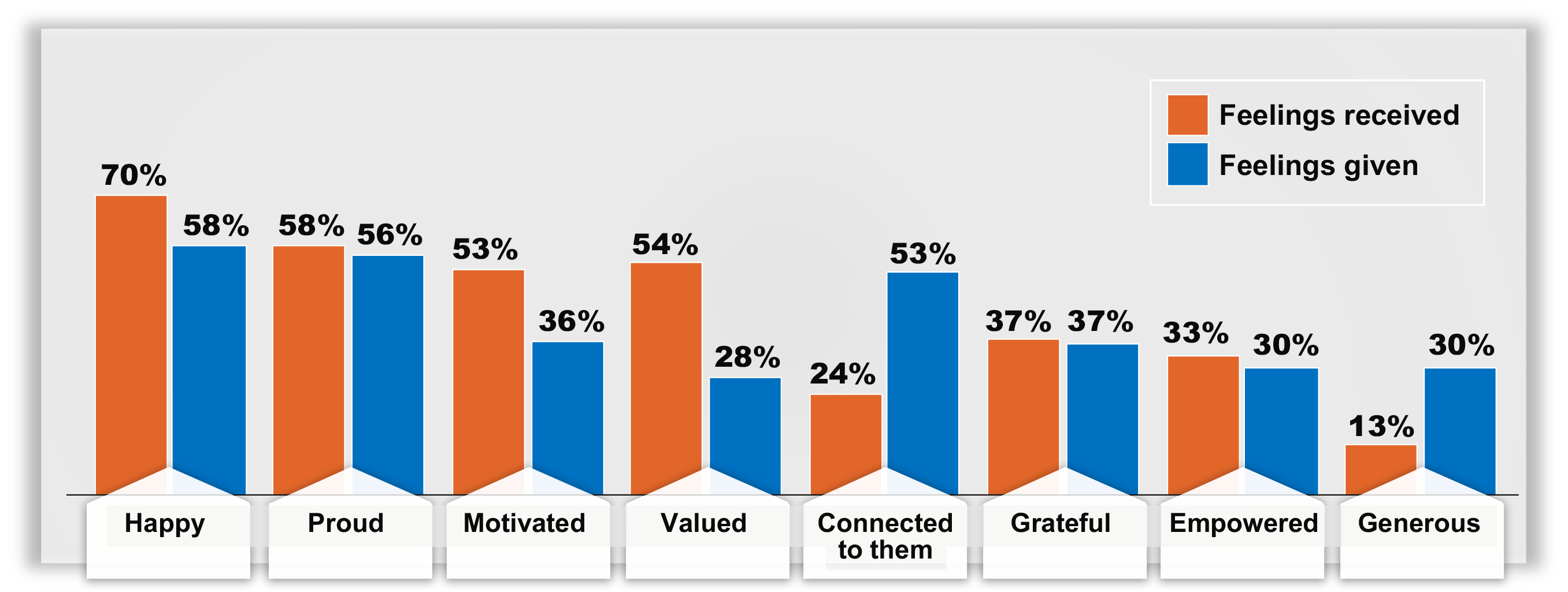6 benefits of showing gratitude at work
Written by: Amy Stern, Vice President, Employee Solutions
(View Author Bio)
We’re all familiar with recognition and how we feel when we’re recognized. But what’s not talked about as much is how showing gratitude benefits the giver. Giving serves a far greater function than just enabling someone else to receive.
Here are six benefits of showing gratitude at work.

- 1 -
Expressing gratitude has physical and mental health benefits.
For some, recognition feels like just one more thing to add to a stressful plate. But it’s helpful to know that expressing gratitude has benefits on physical and mental health. An article from the Mayo Clinic cited that expressing gratitude can improve sleep, decrease depression and anxiety and decrease difficulties with chronic pain. It also helps improve immunity and connections with others.1
- 2 -
Expressing gratitude can improve physiological stress responses in work tasks.
Gratitude has been related to improved stress responses. A study placed university students who had been acquainted for a few months into groups and asked them to individually complete a task typically found in a work environment. They were then asked to collaborate to design a product, create a marketing plan and pitch the product. Once that was complete, they individually took turns delivering parts of the product pitch to a panel of judges. To raise the stakes, the teams were told that the winning team would receive $200.
Before the tasks began, the groups were split into two conditions. One half of the groups included a teammate that was expressing gratitude to the other. The other half of the groups just talked about their days. The study found that the teams who experienced the gratitude condition had superior physiological responses in both the collaborative task and the individual task compared to the control group.2
- 3 -
Gratitude promotes culture.
We also see gratitude’s impact in real life, not just in university studies. BI WORLDWIDE’s annual New Rules of Engagement® research surveys employees of large organizations to better understand their experiences at work. This year, we asked questions around gratitude and we found that those who reported feeling a strong sense of gratitude at work are ten times more likely to say they belong at their organization, have a great company culture and would recommend their organization as a great place to work.3
- 4 -
Giving recognition is one way to express gratitude – and it feels great too.
Those who gave recognition in the past month scored 11 percentage points higher on the item “I have so much to be grateful for.” And those who give and receive recognition experience positive emotions after the event.3

- 5 -
Recognition is contagious.
More giving can create a domino effect. Those receiving recognition in the past month are three times more likely to have given recognition in the past month as well. In fact, whether someone received recognition in the past month was the best predictor of whether they gave recognition, an even stronger predictor than their typical recognition behavior.3
- 6 -
Gratitude spurs prosocial behaviors.
Academic research also suggests that those viewing recognition are more likely to build connections and helpful behaviors with givers and receivers, creating the culture we want to see at work and opportunities for them to be recognized.4
____________________
So what can you do to help drive gratitude at work? Reflecting on what you’re grateful for at work – both the little things and the big things – and recognizing your teammates is important. Celebrating World Gratitude Day on September 21st as a team and setting a goal to express gratitude that day and that week can spur others to do the same.
____________________
Sources
1. Logan, A. (2022). Feeling grateful improves health. Mayo Clinic.
2. Gu,Y., Ocampo, J. M., Algoe, S. B., & Oveis, C. (2022). Gratitude expressions improve teammates’ cardiovascular stress responses. Journal of Experimental Psychology: General, 151, 3281–3291.
3. Hirschfeld, M., Mezera, R., & Stern, A. (2023). BI WORLDWIDE’s New Rules of Engagement® Employee Inspiration Research Report. BI WORLDWIDE.
4. Algoe, S. B., Dwyer, P. C., Younge, A., Oveis, C. (2020). A new perspective on the social functions of emotions: Gratitude and the witnessing effect. Journal of Personality and Social Psychology, 119, 40-74.
The best way to get started is to get in touch.


















